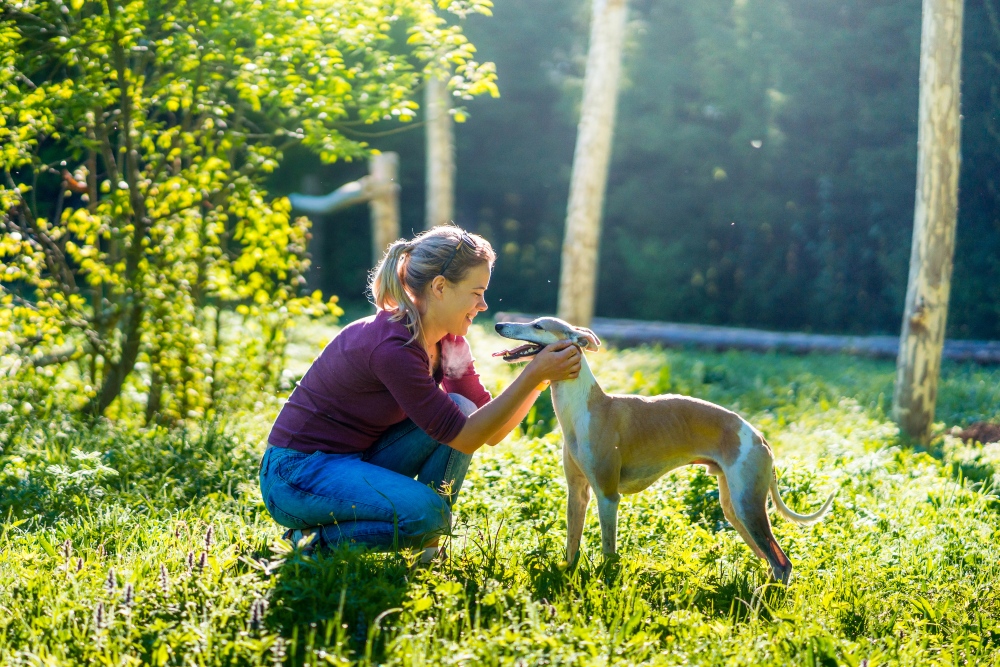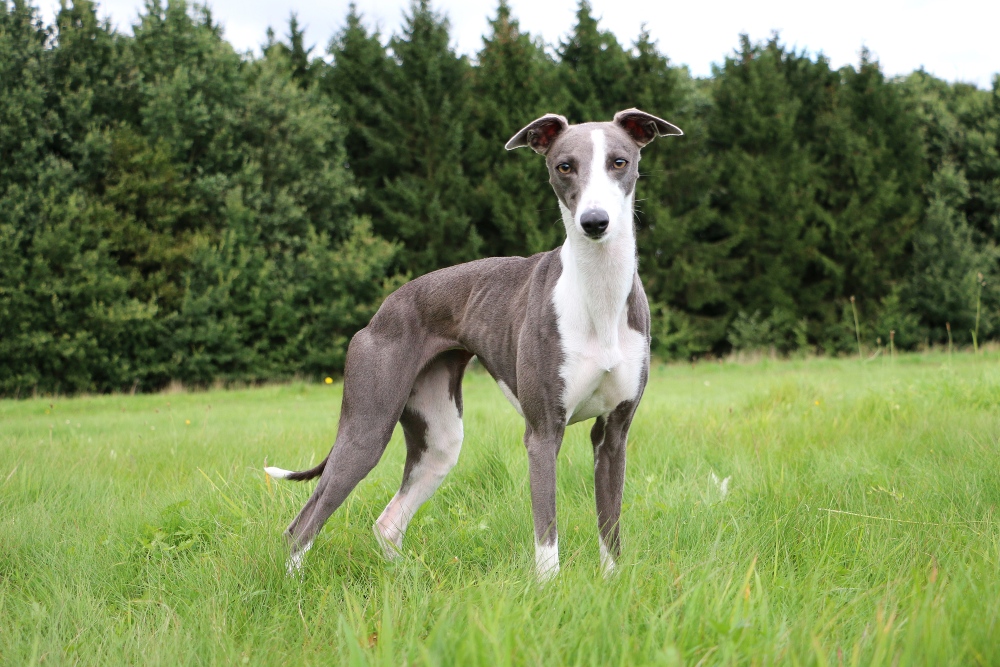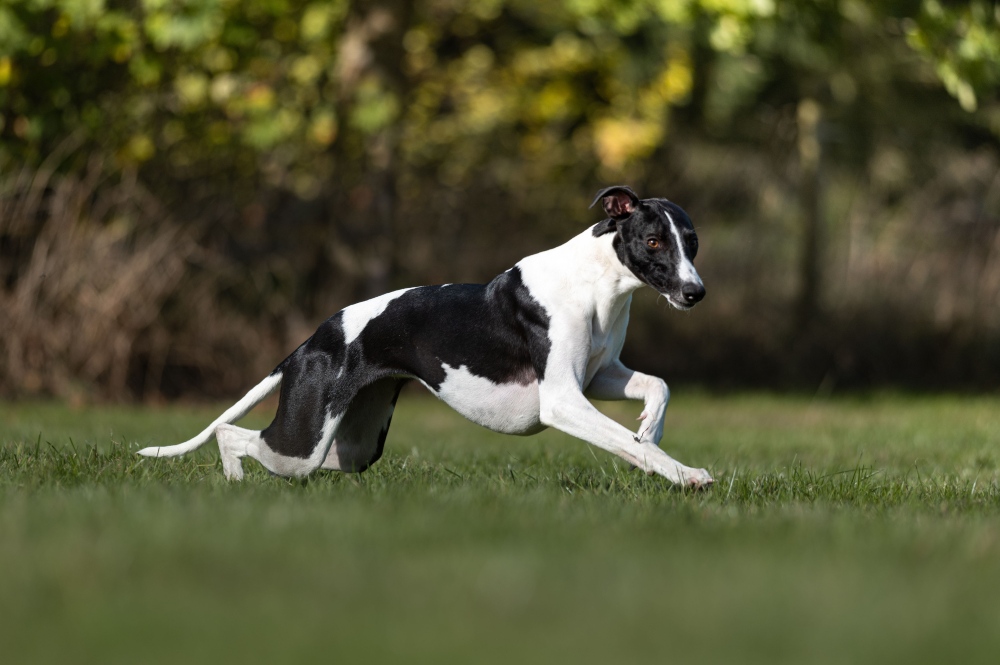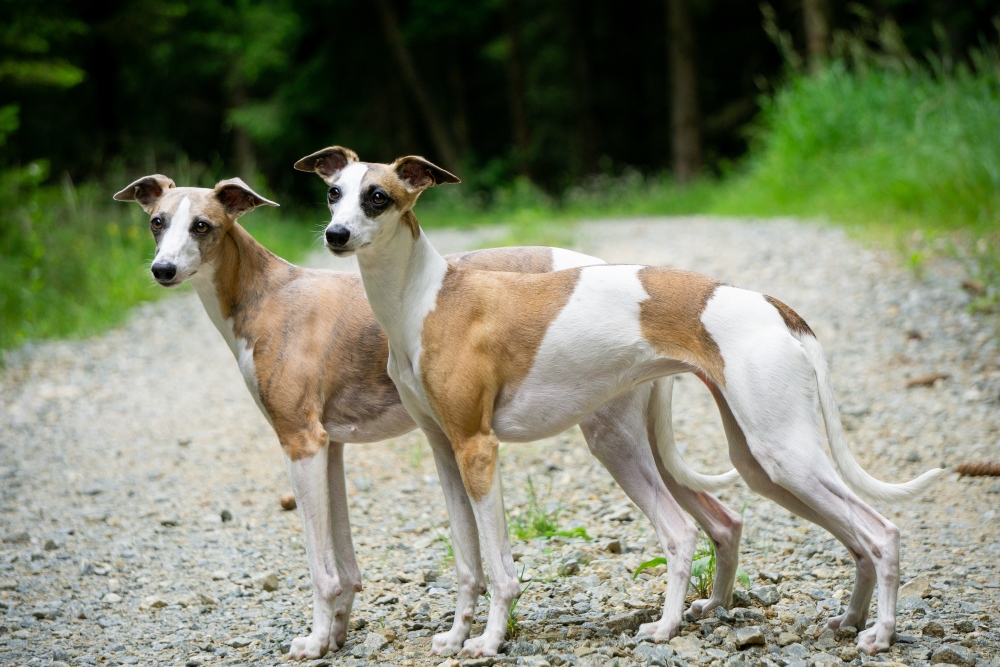Table of Contents
Introduction to Whippets
As part of the Hound Group of dogs, the whippet is a medium-sized dog that is known for its hunting abilities and friendly personality. These are quick and agile dogs that have a stylish look. They are versatile and can live in various home environments, but they do need a moderate amount of exercise each day to stay healthy and happy.
If you’re curious to learn more about the whippet and whether this is the right dog for you, then you’re in the right place! Here is Healthy Paws’ whippet breed guide with all the basics you need to know.
Size of Whippets
For weight, whippets range in size from 25 to 40 pounds when fully grown. Male whippets stand 19 to 22 inches tall, and female whippets are 18 to 21 inches tall as adults. Whippets grow most quickly during the first eight months of life and are considered to be fully grown by around one year of age.
Here’s how big you can expect your whippet to get as the dog grows from puppyhood to adulthood. Male weights are on the high end of these ranges, while female weights are on the low end.
| Weight Chart | 3 months | 6 months | 9 months | 12 months |
| Female and male whippets | 9 – 17 lbs. | 20 – 33 lbs. | 22 – 36 lbs. | 25 – 40 lbs. |
Characteristics of Whippets
Whippets are quiet dogs that rarely bark and also adaptable dogs able to live in both apartments and houses with yards. They are sensitive dogs that get along with nearly anyone they meet and are easy to groom. However, prospective pet parents should know that whippets have a strong prey drive. They love to chase anything that moves but typically get along well with children and other dogs in a household. Surprisingly, they need only a moderate amount of exercise. They love walks and to have the opportunity to really stretch their legs in a safely enclosed area, but then are content spending the rest of their day hanging out with their people.
As you get to know a whippet’s personality, here’s what you can expect based on his or her breed characteristics:
| Breed Characteristic | Level (High, Medium, Low) |
| Affectionate with People | High |
| Good with Kids | High |
| Good with Pets | Medium |
| Need for Exercise | Medium |
| Energy Level | Medium |
| Intelligence Level | Medium |
| Able to Be Trained | Medium |
| Amount of Barking | Low |
| Amount of Shedding | Low |
History of Whippets
The history of the whippet dates back to 18th century England when the dogs were bred to hunt rabbits and serve as gambling entertainment. Whippets were once called the “poor man’s racehorse” because of how fast they could run to snatch up rabbits or a cloth rag in a competition. North-country coal miners loved watching these dogs race and could afford to feed and kennel them better than the larger greyhound dogs. In fact, the whippet can reach speeds of up to 35 miles per hour when running.
This is one of the top sprinting dogs in the world and a frequent winner in lure-coursing and other dog competitions. Textile workers from Lancashire immigrated to New England in America in the early 20th century and brought their whippets with them. The American Kennel Club registered its first whippet in 1888 and started officially recognizing the breed at that time.

Whippet Standard Information
The physical appearance of a whippet is similar to a greyhound but smaller. They have lean heads, small waists, and long legs. This physique allows them to be agile and fast runners, and they are a true sporting hound.
Here is an overview of the breed standard information for whippets:
Head:
- Alert and intelligent expression
- Large and round-to-oval eyes that are dark brown or nearly black
- Rose ears that are small and fine in texture
- Long and lean skull, wide between the ears
- Long and powerful muzzle
- Scissors bite
Neck, Topline, Body:
- Long, clean, and muscular neck
- Backline runs smoothly from the withers
- Deep brisket nearly reaches the point of the elbow
- Ribs well-sprung but not barrel-shaped
Forequarters:
- Shoulder blades long and well-laid-back
- Steep shoulder and short upper arm
- Pasterns strong and slightly bent
- Toes long and well-arched
- Dewclaws may be removed
Hindquarters:
- Long and powerful hindquarters
- Hocks well let down and close to the ground
Coat:
- Smooth, short, and firm in texture
- Dogs are not judged harshly if they have scars or injuries from a work accident
Color:
- Color is immaterial
- Color can be black, white, red, blue, fawn, brindle, cream, or a combination of colors
Gait:
- Free-moving, low, and smooth gait
- Strong drive in the hindquarters
Caring for Whippets
Life with a whippet is fun and full of adventure. Especially if you live in a small space, you will have to prioritize exercise for your whippet. But once the dog has gone for a walk or run, he or she will love cuddling up on the couch with you and feel quiet and peaceful to be around.
Here are some general tips for taking the best care of a whippet:
Best Living Environments:
- Apartments are okay if exercised frequently
- Houses with a yard that is secured with a six-foot fence
- Don’t trust only an underground, electronic fence with a whippet
- Homes with kids and other dogs are okay
Type of Exercise:
- At least two 30-minute walks daily
- Off-leash running time is a fenced enclosure
- Dog parks to expend energy and socialize
- Reduce the length of exercise time for puppies so they don’t overdo it
Mental Enrichment:
- Agility sports, like flyball and lure-coursing
- Plenty of active games to expend energy and stimulate the mind
Training Strategies:
- Generally easy to housetrain and crate-train
- Use patience, praise, and positive reinforcement during training
Grooming Tips:
- Brush the coat weekly with a soft brush or hound gloves
- Only need to bathe occasionally unless the dog gets very dirty outside
- Check for skin scrapes and infections regularly
- Brush teeth daily
- Look for redness or soreness in the eyes, ears, nose, and mouth
- Trim nails monthly unless worn down naturally from running

Common Health Problems of Whippets
The good news for whippet pet parents is that this breed generally enjoys a long and healthy life, with an average life expectancy of 12 to 15 years. However, even whippets are prone to certain medical conditions that can compromise their quality of life.
These are some of the most common health issues that arise with whippets:
- Eye diseases
- Deafness
- Hypothyroidism
- Anesthesia sensitivity
A rare genetic condition that affects whippets is Bully Whippet Syndrome, a gene mutation that affects a dog’s muscular growth. Genetic testing can detect this condition. According to the Canine Health Information Center, whippets should also be screened for eye diseases, heart disease, deafness, hypothyroidism, and hip dysplasia prior to breeding.
Diet and Nutrition for Whippets
Most adult dogs will thrive when eating a high-quality, nutritionally complete and balanced dog food. Whippet puppies should eat puppy food until they are around 12 months old. If you feed your whippet homemade dog food, make sure you are working from a recipe that is designed by a veterinary nutritionist and is appropriate for your dog’s age and health status.
Feed the amount of dog food needed to keep your pet slim. You should be able to see your dog’s waist and feel (but not see) their ribs without having to press too hard. In general, puppies need more calories per day than adults, but a dog’s needs will vary with his or her activity level and other factors. Don’t leave food out all day for a whippet to graze on. Divide the total amount of food for the day into at least two meals for adults and three or four meals for puppies. Place the food out in a bowl at approximately the same time each day.
Talk to your veterinarian if you have any questions about your whippet’s diet or health.
Where to Adopt or Purchase Whippets
The American Whippet Club offers membership opportunities for pet parents of purebred whippets, plus general information about the breed and event information. If you choose to buy a puppy or adult whippet from a breeder, make sure that the breeder is a reputable one that breeds dogs ethically and ensures that all health checks are in place.
You can also adopt a whippet from a rescue organization, such as the National Whippet Club of Canada and the Northern California Whippet Fanciers Association. Whippet Rescue and Placement is a national rescue organization that helps find loving homes for whippets in need.

Related Breeds
If you are looking for a medium-sized dog, an energic and athletic dog, or a dog that has the potential to enter canine competitions, the whippet is a great choice. Before making the big decision to purchase or adopt a whippet, you might also want to learn about some similar and related breeds that share common characteristics with the whippet, such as these breeds and crossbreeds:
- Greyhound
- Italian greyhound
- Azawakh
- Collie whip
- Aussie whip
- Whipoodle
Pet Insurance for Whippets
Even a dog as healthy and active as the whippet can benefit from pet health insurance. It is common for whippets to require veterinary care due to running-related accidents and emergency hospitalizations. Not only does Healthy Paws cover these types of vet visits, but also care due to genetic and breed-specific conditions. If your vet recommends alternative care for your whippet, Healthy Paws can even cover that too.
On our website, you can see your rates for whippet pet insurance and enroll your dog in an affordable and flexible plan that works for you. If you have any questions about how dog insurance works and what it covers, please give us a call at 855-898-8991.









